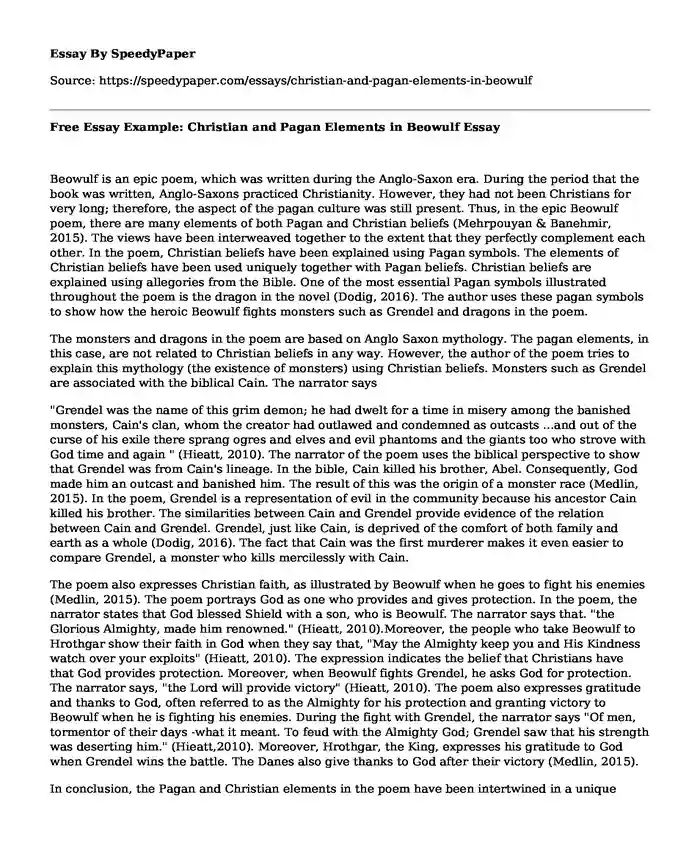
| Type of paper: | Essay |
| Categories: | History Christianity Beowulf Mythology |
| Pages: | 3 |
| Wordcount: | 772 words |
Beowulf is an epic poem, which was written during the Anglo-Saxon era. During the period that the book was written, Anglo-Saxons practiced Christianity. However, they had not been Christians for very long; therefore, the aspect of the pagan culture was still present. Thus, in the epic Beowulf poem, there are many elements of both Pagan and Christian beliefs (Mehrpouyan & Banehmir, 2015). The views have been interweaved together to the extent that they perfectly complement each other. In the poem, Christian beliefs have been explained using Pagan symbols. The elements of Christian beliefs have been used uniquely together with Pagan beliefs. Christian beliefs are explained using allegories from the Bible. One of the most essential Pagan symbols illustrated throughout the poem is the dragon in the novel (Dodig, 2016). The author uses these pagan symbols to show how the heroic Beowulf fights monsters such as Grendel and dragons in the poem.
The monsters and dragons in the poem are based on Anglo Saxon mythology. The pagan elements, in this case, are not related to Christian beliefs in any way. However, the author of the poem tries to explain this mythology (the existence of monsters) using Christian beliefs. Monsters such as Grendel are associated with the biblical Cain. The narrator says
"Grendel was the name of this grim demon; he had dwelt for a time in misery among the banished monsters, Cain's clan, whom the creator had outlawed and condemned as outcasts ...and out of the curse of his exile there sprang ogres and elves and evil phantoms and the giants too who strove with God time and again " (Hieatt, 2010). The narrator of the poem uses the biblical perspective to show that Grendel was from Cain's lineage. In the bible, Cain killed his brother, Abel. Consequently, God made him an outcast and banished him. The result of this was the origin of a monster race (Medlin, 2015). In the poem, Grendel is a representation of evil in the community because his ancestor Cain killed his brother. The similarities between Cain and Grendel provide evidence of the relation between Cain and Grendel. Grendel, just like Cain, is deprived of the comfort of both family and earth as a whole (Dodig, 2016). The fact that Cain was the first murderer makes it even easier to compare Grendel, a monster who kills mercilessly with Cain.
The poem also expresses Christian faith, as illustrated by Beowulf when he goes to fight his enemies (Medlin, 2015). The poem portrays God as one who provides and gives protection. In the poem, the narrator states that God blessed Shield with a son, who is Beowulf. The narrator says that. "the Glorious Almighty, made him renowned." (Hieatt, 2010).Moreover, the people who take Beowulf to Hrothgar show their faith in God when they say that, "May the Almighty keep you and His Kindness watch over your exploits" (Hieatt, 2010). The expression indicates the belief that Christians have that God provides protection. Moreover, when Beowulf fights Grendel, he asks God for protection. The narrator says, "the Lord will provide victory" (Hieatt, 2010). The poem also expresses gratitude and thanks to God, often referred to as the Almighty for his protection and granting victory to Beowulf when he is fighting his enemies. During the fight with Grendel, the narrator says "Of men, tormentor of their days -what it meant. To feud with the Almighty God; Grendel saw that his strength was deserting him." (Hieatt,2010). Moreover, Hrothgar, the King, expresses his gratitude to God when Grendel wins the battle. The Danes also give thanks to God after their victory (Medlin, 2015).
In conclusion, the Pagan and Christian elements in the poem have been intertwined in a unique manner. The poem incorporates the Christian and Pagan elements without undermining any of the elements. The Christian elements have been used extensively to explain the Pagan elements such as the Anglo-Saxon-based elements in the novel. The poem has used useful illustrations to indicate these elements.
References
Dodig, V. (2016). Christian Elements in Lord of the Rings and Beowulf (Doctoral dissertation, Josip Juraj Strossmayer University of Osijek. Faculty of Humanities and Social Sciences.) Retrieved from< https://repozitorij.ffos.hr/en/islandora/object/ffos%3A166>
Hieatt, C. (2010). Beowulf and Other Old English Poems. Bantam Classics.
Medlin, J. M. (2015). The Interwoven Traditions of Beowulf: Interweaving the Pagan Past, Christian Present, and Local Aesthetic in Beowulf (Doctoral dissertation, University of Georgia). Retrieved from < https://getd.libs.uga.edu/pdfs/medlin_jenny_m_201505_ma.pdf>
Mehrpouyan, A., & Banehmir, S. S. A. (2015). Reflection of fate in epic-mythological heroes: Beowulf and Rustam. International Journal of Research in Social Sciences, 5(1), 208. http://papers.iafor.org/wp-content/uploads/papers/libeuro2014/LibEuro2014_03735.pdf
Cite this page
Free Essay Example: Christian and Pagan Elements in Beowulf. (2023, Mar 20). Retrieved from https://speedypaper.net/essays/christian-and-pagan-elements-in-beowulf
Request Removal
If you are the original author of this essay and no longer wish to have it published on the SpeedyPaper website, please click below to request its removal:
- Free Essay: Family Structure and Juvenile Delinquency
- Texas Is a Small-Government State - Free Essay Sample
- Business Essay Sample: Review of the Solyndra Bankruptcy and Current Events
- Essay Sample Describing Ethics in Business
- Free Essay on Sustainable Development and Hospitality Industry
- Essay Example - Performance Appraisal
- Essay Sample on The Rise of Newark
Popular categories




